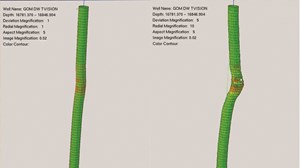Technological advancements rise to the challenge of new regulations
In April 2016, amid continuing worries about oil pricing, Gulf of Mexico (GoM) operators were presented with a new challenge: additional requirements for offshore drilling activity in the U.S. Aiming at reducing environmental and safety risks, the Bureau of Safety and Environmental Enforcement (BSEE) published the final version of its well control rule. As the new regulations on well safety, integrity, and control systems get absorbed and implemented by stakeholders, some industry players have suggested that the cost of compliance may reach uneconomical levels.
It may be somewhat early for that verdict, and economic analysis will ultimately hinge on oil price. While operators will need to make additional financial investments to meet the new measures, service providers have already taken several steps toward improving efficiency in offshore markets by developing new technologies that will ease the burden.

One significant example is the recent launch of the extended-range (ER) Weatherford CalView service. The service is one of the components of the SecureView platform, commercialized in 2015, which enables operators to obtain a full view of casing and cement conditions by taking four different measurements simultaneously. The new CalView technology enables tri-dimensional imaging of varying casing internal diameters along the borehole.
Multi-caliper logging is by no means new; however, the design of the new CalView technology greatly improves the efficiency of measurement. This technology is the first of its kind capable of evaluating well integrity in the wide range of casing sizes used in the GoM. The service is also well suited for deepwater deployment, with the ability to withstand 30 kpsi of downhole pressure. It can be quickly run from bottomhole back to surface on wireline.
In one configuration, the CalView logging tool enables multi-caliper readings ranging from 6 in. to 16 in. in one pass, meaning that the operator can assess the casing condition without the need to pressure test the well in the middle of the drilling process.
Meeting BSEE well-integrity requirements
Well integrity is an increasingly vital domain, and worthy of the recent attention it has gained in the industry. The BSEE well control rule reflects this, stipulating that if wellbore operations continue for more than 30 days after pressure testing, casing and/or liner integrity must be re-assessed using another pressure test or an evaluation logging run. The rule further specifies that the logging method must include either a multi-caliper tool or an imaging tool. There may be additional requirements on a case-by-case basis, at the discretion of the District Manager. Results of the evaluation will dictate whether operations can resume or if remediation is needed.
This extra level of testing offers an opportunity for time-saving innovations. The typical pressure test requires operators to rig up a bottomhole assembly, trip in, test, and trip out, which usually consumes 2 to 3 days of nonproductive time. Additionally, traditional multi-caliper tools require multiple cable runs to cover different casing diameters; cannot withstand the downhole pressures prevalent in the GoM; or may even fail to provide a reliable assessment of the integrity status. The ER CalView tool improves upon traditional tools with its large multi-caliper coverage, 30-kpsi capability and a wider casing-size range. It offers a high sampling rate that increases the visibility of casing damage, and works with all mud systems.
Improving on an established tool
Prior to the launch of the ER CalView service, an earlier version of the technology with a lower pressure rating and slightly lower casing size range was successfully deployed in the GoM more than a dozen times since 2014. The extended-range, high-pressure version substantially expands the scope of the CalView service in the GoM and beyond.
In one of its first deployments in the deepwater GoM, the extended-range CalView service was run in a specific interval where the operator had issues running clean-out scrapers in preparation for completion. The CalView service identified that the casing had shifted in a fault within a salt formation and gave the precise geometry and location of the problem. Analysis of the data through the use of Weatherford T-Vision tri-dimensional software revealed that, despite the shift, the casing was intact with the internal diameter only minimally different from when it was run in hole. Because the operator was able to clearly show that the casing was not compromised, the proposed completion program was accepted as compliant. Additionally, the drift analysis enabled by the CalView data provided the operator with the precise packer length and outside-diameter requirements to fit the casing parameters.
Other noteworthy applications for the ER CalView include casing imaging before drilling sidetrack wells, determining wear inside the casing collars with internal upsets, and offshore riser inspections. For wells with ultra-high deviation, the deployment of roller systems in combination with the CalView service enables logging to be carried out smoothly via traditional wireline runs. CalView tools can be deployed in holes with deviations up to 88 degrees and the instrument’s telemetry flexibility allows the job to be run off any wireline unit.
Conclusion
In an era marked by greater attention not only to environmental and safety issues but also to downhole asset integrity and extreme cost efficiency, operators have been forced to take a pragmatic approach to technology adoption. As frontline operators in the GoM adjust to the new well-control rule, they must be attentive to technology developments and applications that assure full compliance while boosting the efficiency of drilling and completion operations. New technologies such as the ER CalView service are transforming the way both operators and regulators assess and safeguard the integrity of newly cased wells.


